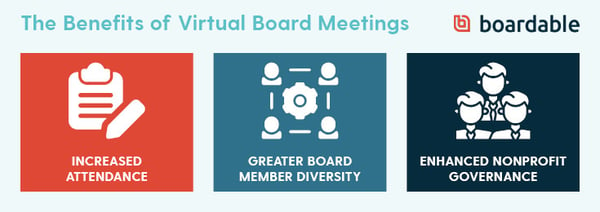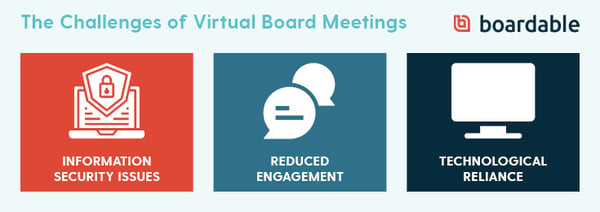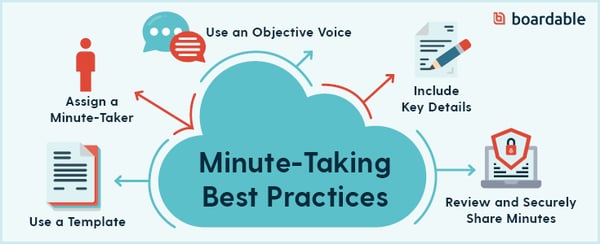October 22, 2020
 by Jeb Banner / October 22, 2020
by Jeb Banner / October 22, 2020

With remote work taking the world by storm, businesses and nonprofits rely on a board of directors to overcome major challenges like these, as well as make key decisions, generate community support, and craft strategic plans.
These objectives must still be accomplished, even when in-person meetings are not safe or feasible. Historically, board meetings have been held in the aptly-named boardroom, but like most things this year, they’ve gone virtual.
A virtual board meeting is held online with the help of video conferencing software. Although any kind of virtual gathering can struggle with technical difficulties, challenges with engaging participants, and a lack of efficiency, it’s possible to get just as much done in your virtual board meetings as you can in person.
The following guide will explore the ins and outs of a virtual board meeting, offer strategies to maximize your impact, and answer questions including:
Digital board meetings are currently the best choice for any board that needs to meet while adhering to social distancing guidelines.
They can be held by any business, association, or other organization that needs to adapt to the needs of a digital workplace, but this guide will speak specifically to the needs of nonprofit boards.
Before diving into the planning process for your next virtual board meeting, double-check that you’re following the appropriate protocols. State regulations or your organization’s own bylaws may have restrictions in place for what is and isn’t allowed in a virtual meeting. For instance, you may be unable to hold a vote as easily as you would in person.
Some bylaws may even prohibit virtual meetings completely. If this is the case, you may need to consider amending the rules in order to move forward with board business. Virtual board meetings are particularly necessary during our current times, but as we’ll cover later, they can be useful even when it is possible to meet in person.
While both in-person and virtual meetings can be productive and engaging, there are some major differences between the two that should be considered.
Changing the meeting format leads to changes in member participation and engagement as well as technology and security. While some of these differences are definite disadvantages of virtual board meetings, they can easily be addressed with the right tools and planning strategies.
Virtual board meetings present the key advantage of enabling your board to convene safely while remote. Since your nonprofit’s operations must persist regardless of extenuating factors, it’s critical to still solicit the advice and support of your board members in whatever capacity you are able.

Virtual board meetings offer several major benefits, including:
Each of these advantages extends beyond the circumstances of the pandemic, so even once things are back to normal, it may be worth considering holding all your board meetings virtually.
Unfortunately, change and innovation can have downsides. Whenever you introduce something new to an organization, problems will inevitably arise. However, some extra caution and planning ahead can reduce the impact of these challenges.

Virtual board meetings can have risks, including:
Be sure to stay aware of these potential pitfalls even after you’ve taken steps to address them. As long as you stay on top of these risks, you’ll be able to host successful (and problem-free) virtual meetings.
With any board meeting, you need a plan in place to maintain productivity. Otherwise, it can be easy for the conversation to get off track, and before you know it, the allotted meeting time will be over with several key decisions still left on the agenda. Or worse, if you weren’t using an agenda, you might omit important topics completely!
These concerns are just as prevalent at an in-person meeting, but going remote can add more challenges to the mix. However, with the right strategies and tools in place, a virtual meeting can be every bit as effective as an in-person meeting.
More than likely, your virtual board meeting is taking place over video conferencing software. Most platforms make it simple to host a meeting and record the conversation, but your board likely has other needs as well.
Cobbling together a patchwork system of tech tools can facilitate your virtual meeting, but it opens up the possibility that things could fall through the cracks or time could be wasted.
Instead, the easiest way to make sure you have a platform that meets all of your needs is to implement dedicated board software. Keeping communication, documents, meeting information, and even the meeting itself in one centralized place can help everyone stay organized and efficient.
If you’re considering implementing specialized board management software, you’ll want to look for features including video conferencing tools, a document management system, scheduling, and communication options. You’ll also want to confirm your chosen platform is compatible with any popular third-party tools your members rely on.
Setting a board meeting agenda ahead of time is one of the best ways to ensure your meeting runs successfully. After all, things can’t exactly go as planned if you don’t start with a plan in the first place.
Aim to send out the board meeting agenda approximately a week before the meeting. This will give each board member a chance to review the materials, add the necessary information, and come prepared with questions and talking points.
When designed strategically, a meeting agenda is more than just a quick list of conversation topics. An effective agenda will:
At an in-person meeting, you’d probably print and distribute paper agendas. A virtual meeting agenda allows for dynamic capabilities like inline task delegation and easy access to documents to make things even more efficient.
Once you’ve developed a dynamic agenda, stick to it! A well-prepared agenda is meaningless if it is cast aside as soon as the meeting starts. While the item-specific time limits may be an adjustment for your board at first, soon everyone will appreciate how useful they are to respecting members’ valuable time.
To create a productive meeting environment, you must make sure the virtual “environment” is functioning properly and is useful to everyone.
Be sure to troubleshoot your software ahead of time to try and solve any problems outside of the meeting time. This includes testing your own camera, speakers, and microphone and encouraging your board members to do the same. You don’t want someone to log on and miss an important update because they can’t hear anything!
For board members who are not so tech-savvy, you’ll want to provide detailed instructions for getting connected and participating in the discussion. While most virtual meeting software is fairly intuitive, some members may still be unfamiliar or uncomfortable with it at first. Do your best to ease these concerns with plenty of guidance.
Finally, it may be a good idea to discuss best practices for meeting etiquette with your board members. Things will run more smoothly if everyone understands key principles including:
These etiquette guidelines will prevent the meeting from getting off track and create an environment where everyone feels respected. This courtesy will help to keep board members comfortable and engaged in the conversation.
After months of remote work, virtual happy hours, and other video calls, you’ve probably been through the awkward experience of a silent conference call. It can be difficult to foster the same level of remote engagement as would be natural in person.
However, with more intentional conversation tactics and communication strategies, you can still create an atmosphere where board members feel prepared and comfortable participating in discussions. Let’s walk through a few opportunities for establishing a comfortable and productive virtual boardroom.
Ideally, your board members will be comfortable participating from the get-go, and all of your conversations and brainstorming sessions will be as productive and lively as usual.
But as you probably know from experience, this isn’t guaranteed. Instead, you must actively promote the same open environment as you had in the physical boardroom. Remind your members that their perspectives are welcome, even if they disagree with other members or leadership. Speaking up with dissenting opinions in a video call may feel unnatural, but it’s crucial to making the best decisions possible for your nonprofit.
You also want to cultivate a feeling of trust. In a remote meeting, board members may feel less willing to disclose sensitive information or voice a legal concern. If you use secure meeting software, you can assure board members that their thoughts are still confidential.
One potential roadblock to engagement is your meeting infrastructure. If you don’t provide easy access to the right documents and board management tools, you’re setting the meeting up for failure – or at least for a lack of participation.
Ensure that all relevant materials are available to members during the meeting. If you’re using a dynamic agenda, it will be easy to include everything in one place. If not, do your best to distribute additional documents to review ahead of time. If you or your members have to search for something during the meeting, you’ll waste valuable time and may risk members not being prepared for discussion.
Another option is to implement team collaboration tools, such as polling. These resources will fuel a healthy environment of collaboration that will help drive your nonprofit’s mission forward.
In a virtual meeting, you must intentionally build opportunities for interaction into the structure of the meeting. Without the body language and social cues of an in-person conversation, the fear of interrupting may prevent some board members from speaking up. To help combat this, explicitly ask for comments and questions from board members throughout the duration of the meeting.
At the beginning of the meeting, open the discussion by calling on each board member to participate. A cursory inquiry like, “Does anyone have something to add to the agenda?” isn’t enough – it’s better to make sure that everyone participates. This way, you promote collaboration from the outset.
Once the conversation is underway, be sure to pause every so often to solicit feedback from members. Since it’s much harder to interject in a remote environment, it’s best to purposefully create these openings. Otherwise, members might save questions for the end of the meeting and potentially forget about them.
Detailed documentation is critical to the effectiveness of your virtual meeting. Thorough notes on discussion points and next steps are the best way to carry a productive conversation forward.
This documentation provides helpful context to absent members, helps future board leaders make informed decisions, and even informs outside parties like regulatory agencies. Let’s walk through a couple primary steps for sufficient virtual meeting documentation.
Minutes are the permanent, official documentation of your digital board meeting. While they are a useful internal resource, they also serve as a legal record should you ever encounter legal complications.

The following minute-taking best practices will help ensure this record is clear, accurate, and complete:
When considering what information to include, your minute-taker should aim for a balance between concise and thorough. Avoid including the individual votes or opinions of members, off-the-record discussions, and any conversation that could have legal ramifications.
When your virtual meeting draws to a close, everyone should have a clear understanding of their next steps. Specifically, what actions need to be taken ahead of the next meeting?
If any item on the agenda has a follow-up task, it’s best to assign it right then and there. With a dynamic agenda, you can delegate it to the appropriate member without losing momentum. Or, you can keep a running list of to-dos throughout the meeting and assign them in post-meeting follow-up. Either way, be sure to clearly define the task and determine a deadline.
With direct task delegation, you can avoid the uncomfortable scenario of arriving at the next meeting and realizing that important action items were left unassigned and incomplete.
A nonprofit’s board is a key component of its success in fundraising initiatives and community impact. As nonprofits continue to operate during the pandemic and the resulting social distancing guidelines, virtual meetings will remain essential. Even without an in-person boardroom to gather in, your board can still hold lively and high-impact meetings. Good luck!
Jeb Banner is the founder and CEO of Boardable, a nonprofit board management software provider. He is also the founder of two nonprofits, The Speak Easy and Musical Family Tree, as well as a board member of United Way of Central Indiana and ProAct. Jeb is based in Indianapolis, Indiana.
Board meetings are where strategy becomes action or stalls completely.
.png) by Audrey Quiteves
by Audrey Quiteves
We’ve all been stuck in a meeting that seemed pointless or went on too long without any...
 by Derek Doeing
by Derek Doeing
Board meetings are where strategy becomes action or stalls completely.
.png) by Audrey Quiteves
by Audrey Quiteves
We’ve all been stuck in a meeting that seemed pointless or went on too long without any...
 by Derek Doeing
by Derek Doeing



